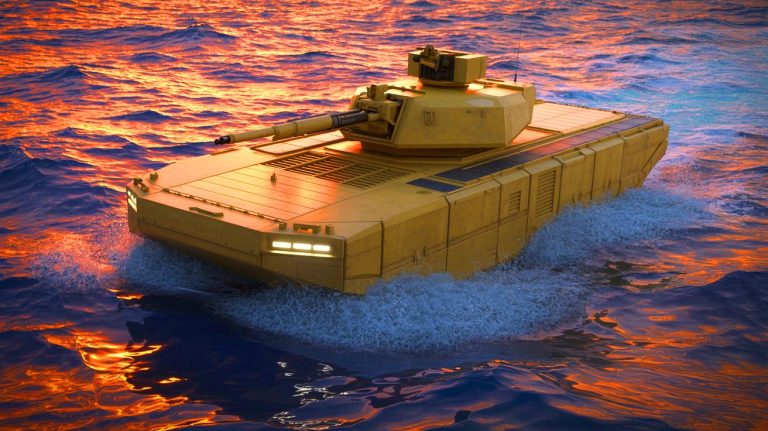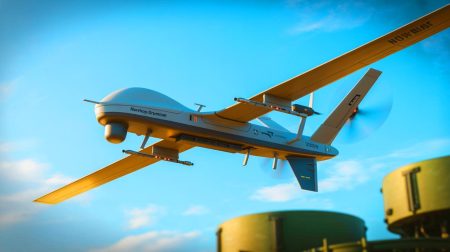| IN A NUTSHELL |
|
In a bold move to enhance its amphibious warfare capabilities, the U.S. Marine Corps has contracted BAE Systems to produce the ACV-30, an upgraded version of the Amphibious Combat Vehicle. This decision comes on the heels of China’s recent military advancements, highlighting the U.S. commitment to maintaining superiority in marine combat technology. With a $188.5 million investment, the new ACV-30s promise to integrate cutting-edge lethality, survivability, and maneuverability, ensuring the Marines are well-equipped for future challenges. But what makes these vehicles a game-changer in modern warfare?
The 8×8 Amphibious Tank Revolution
The ACV-30 represents a significant leap in amphibious combat vehicle technology. As an enhanced version of the baseline ACV platform, it is designed to provide direct fire support for Marine infantry units operating in diverse and often hostile environments. Central to its design is the Medium Caliber Remote Turret System (RTS), allowing precision fire with a 30mm cannon while keeping crew members safe through remote operation. This dual-domain capability is engineered for seamless transition from open-ocean transit to shore-based operations, making it incredibly versatile.
Rebecca McGrane, Vice President of Amphibious Programs at BAE Systems, emphasized the adaptability of the ACV-30, noting its proficiency in executing amphibious assaults, island seizures, and prolonged inland engagements. Its buoyancy and hydrodynamic profile enable over-the-horizon ship-to-shore maneuvers, crucial for maintaining operational tempo and troop protection. This adaptability positions the ACV-30 as a formidable asset in modern amphibious warfare.
The ACV Family: A Comprehensive Approach
The ACV-30 is part of a broader family of vehicles designed to meet various operational needs. This family includes the ACV-Personnel (ACV-P), ACV-Command (ACV-C), and the in-development ACV-Recovery (ACV-R). Each variant serves a distinct purpose, enhancing the overall capability of Marine operations. The ACV-P focuses on troop transportation, capable of carrying 13 Marines and three crew members safely. Meanwhile, the ACV-C acts as a mobile command center, equipped with digital workstations for real-time battlefield management and situational awareness.
The ACV-R is currently in prototype testing and is designed for field maintenance, battlefield recovery, and repair operations, all critical for sustained amphibious maneuvers. The production of these vehicles is distributed across BAE’s U.S. industrial base, with key manufacturing sites in York and Johnstown, Pennsylvania, and Charleston, South Carolina. The completion of the contract is anticipated by the third quarter of Fiscal Year 2026, underscoring a strategic commitment to defense readiness.
Unleashing the Power of the 30mm Cannon
The ACV-30 is armed with the Kongsberg MCT-30 remote turret system, featuring the Northrop Grumman Mk44 Bushmaster II 30mm chain gun. This primary armament is capable of firing a variety of NATO-standard ammunition, including armor-piercing and airburst munitions, providing versatile engagement options against a range of threats. The vehicle also includes a secondary coaxial 7.62mm machine gun, supported by advanced optics, fire control, and thermal imaging systems.
Retaining full amphibious capability, the ACV-30 is propelled by dual water jets, operating effectively at sea state 3. Its enhanced mine and ballistic protection, coupled with a 700-horsepower six-cylinder diesel engine, ensure both resilience and power. An independent suspension system provides mobility, while the 8×8 wheeled chassis is optimized for cross-country and urban operations alike. Communication and network integration are designed to align with the U.S. Marines’ tactical C4ISR architecture, facilitating interoperability among naval and joint forces.
Strategic Implications and Future Prospects
The introduction of the ACV-30 and its family of vehicles highlights a strategic shift in amphibious warfare, emphasizing flexibility, adaptability, and advanced firepower. By investing in these advanced platforms, the U.S. Marine Corps is not only enhancing its current capabilities but also preparing for future conflicts that may arise in increasingly contested environments. The ACV-30’s design and technology reflect a broader trend towards integration and modernization within military forces, ensuring that the U.S. remains a formidable presence on the global stage.
As these vehicles are integrated into Marine operations, the impact on strategic planning and execution will become increasingly apparent. With the completion of the production contract on the horizon, one must ask: How will these advancements shape the future of amphibious warfare, and what innovations will follow in the coming years?
Did you like it? 4.6/5 (20)









These tanks sound impressive, but how do they compare to other nations’ amphibious capabilities? 🤔
With all this spending, will the US Marines’ budget ever get a break? 🤑
It’s a tank and a boat! What a time to be alive! 🚢
It’s nothing new they’ve had this technology for many years many years
Are these vehicles environmentally friendly in any way?
No, they destroy the Earth
No, they destroy the Earth who cares their weapons of war they save lives of Americans
Is the 30mm cannon really a game-changer or just military hype?
Who else thinks the ACV-30 looks like something out of a sci-fi movie?
Does this mean we’ll see fewer casualties in future amphibious operations?
Will the ACV-30 be deployed in any upcoming exercises or demonstrations?
Yeah, special just for you
Great article, but where’s the info on potential risks or downsides? 🤨
With the focus on amphibious warfare, are other branches of the military getting similar upgrades?
How do the ACV-30 and its variants fit into the broader US military strategy?
What’s the potential lifespan of these ACV-30 vehicles before they need upgrading?
Does the ACV-30 have any autonomous capabilities, or is it purely manually operated?
As a former Marine, this is exciting! Semper Fi! 🇺🇸
Will these new tanks replace older models, or just supplement them?
How do these vehicles perform in urban environments compared to open terrain?
Is it just me, or does $188.5 million seem like a bargain for this capability? 🤷♂️
Thanks for the detailed article! Always good to know where our tax dollars are going. 👍
Are there any plans for international collaborations on similar military technologies?
I bet these tanks could make it to Mars before we do! 🚀
How do the ACV-30 and its 30mm cannon compare to China’s latest amphibious vehicles?
Does the vehicle have any stealth features to avoid detection during operations?
Seems like overkill for shoreline defense… or is it? 🤔
Are these vehicles part of a broader modernization plan for the Marines?
Thanks for sharing this info. Always fascinating to see military tech evolve! 👍
How will the ACV-30s impact the Marines’ current tactics and strategies?
How does the ACV-30 handle choppy waters during amphibious landings?
Hope they have Wi-Fi on board! 😂
Why not invest in more sustainable military tech while we’re at it? 🌍
More military spending, what a surprise! #sarcasm
How does the Kongsberg MCT-30 turret system improve over previous models?
No offense, but some of you people ask the stupidest questions you just ask questions just to see yourself and print